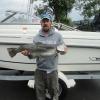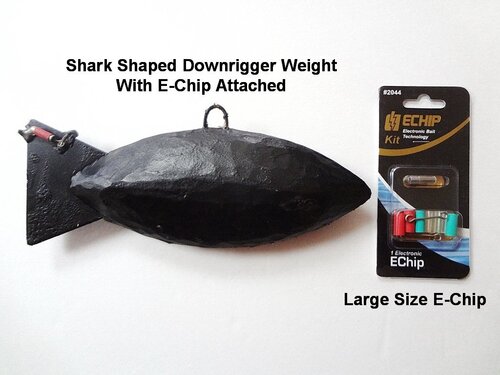-
Posts
13,818 -
Joined
-
Last visited
Content Type
Profiles
Forums
Events
Gallery
Store
Posts posted by Sk8man
-
-
Ah the spineys usually look like "prickly pears" while the fishhooks usually ;look like cotton wood and turn grey and smell to high heaven and are hardest to get off the line. The spineys can usually be removed easier.
-
Spineys or fishhook type?
-
Of the three weights the fish shape will probably track straightest
15 to 50 ft for spoons, 4 - 15 ft for flashers or attractrors with fly or spoon depending on circumstance, targeted fish, depth run, etc. I usually shorten the lead the deeper I go.
Deepest lines usually should be closest to boat but that may not be the riggers; wire divers may be your deepest again depends on circumstances and what you are targeting and running for lures etc..
Easiest way to run multiple lines from riggers is to use sliders. It has been covered multiple times on here so may want to search for the info.
I'm sure others may have other ideas or different info but this is off the top of my head for starters.
-
On the downside....you no longer have any excuses for not catching
 Good luck out there.
Good luck out there.
-
 1
1
-
-
I guess my question would be: "if the other shaped weights track fine why bother running the cannonball weights at all"? I use 10 lb shark type or torpedoes = no problems
-
I'm with Frogger and Longline. Not sure how much weight you are running but maybe also going a bit heavier and go with a torpedo or shark shape as they will resist fanning out more horizontally. The round cannonball type in the lower weight range especially had a tendency to do that and even spin around in strong current sometimes depending on what you were running for a setup. I ran them for over thirty or more years and since switching to the shark type and torpedos have never looked back and have zero problems with them. My Black releases have always been on the cable itself. In the old days when I tried hooking up to back of the weight itself and ran an attractor of any type the blowback was awful; not so when run from the cable. I'm talking about weights in the 8-12 lb range (common in previous years) and I believe the heavier weights used today (15-20 pounds) may be a different story.
-
-
On 6/29/2021 at 8:46 AM, ErieBuck said:
Very cool, great to know! will save me some money for sure. Looks like they make a kit: #2043 Contains - 3 large EChips.
I use them right on my shark type downrigger weights for the past 5 or 6 years unclear whether it is them or the setups that work but I'm superstitious so I keep them on

-
As mentioned the Atlantics often like smaller stuff presented at a little higher speed. They are more of an incidental catch on Lake O but in the Finger Lakes where they occur and there are no Pacific salmon available they will respond to some "Coho- like" presentations like small dodgers (e.g. 6 inch) with meat strips trailing or small sawbellies but placed up higher in the water column generally than the stuff you'd be using on Lake O for kings or lakers etc. Another avenue for running bait is to use Sutton Hemlock Spinners (old school approach) with frozen bait either smelt or sawbelly or in a pinch a shiner run higher in the water column than for lakers. Both Atlantics or Browns respond to it. I have made up small sets of cowbells with Colorado blades that can be used to trail a meat rig or even a hemlock spinner behind it with meat. It is usually the bigger ones that are attracted to the meat setups too.
-
Most folks use the 30 lb 7 strand. An additional brand is Accustrand and I believe emptystringer on here usually has some for sale. I have had good luck with it but I have also used the other brands mentioned and if treated right most brands work fine but you do have to periodically examine them and perhaps cut out any questionable areas for a few feet up. The wire does vary in tensile (breaking) strength and there are differences as in the finish as some are very shiny while others have a "camo" or brownish finish. A critical variable is kink resistance and most wire at 30 pound test kinks fairly easily when the tension is off it ( e..g. curly cues). So in short, it becomes largely a personal preference issue.
-
Hope that isn't a plastic fish Mike is holding up.... I know how competitive he is

-
 1
1
-
-
Nice going John

 I hope this is a good omen for what the rest of the season will be like.
I hope this is a good omen for what the rest of the season will be like.
-
As long as the packaging is available shouldn't be a problem at least the way the reg is worded.
-
Try working on a diagonal starting at about 80 or 90 ft and go outward diagonally running cowbells on or near bottom with cowbells and gambler rigs until you locate either pods of baitfish, marks on bottom, or suspended fish below pods. When you find fish don't just keep going - keep working them back and forth until you connect with something....sometimes you may get a surprise Chinook too and browns can be at the starting point (e.g. in 80-90 ft.) near bottom. The lakers may end up being in the very deep water but not always if bait is around shallower so going on a diagonal you cover a greater range of depths and area.
-
You may want to check inside the downrigger body since you changed out the power wires something (e.g. wires)may be too close together and touch when the boat is moving in the waves and shorting outetc. A connector to the switch may be loose on there too.
-
That's great Kevin. Cool to see some Crappies in the mix too

-
 1
1
-
-
You might try either some chrome polish or silver polish. It will remove SOME spots (depending on what the spoons/or finish are made of). Then wash them with dawn dishsoap to get the scent off them
-
 1
1
-
-
Works well with the Spiny Fleas but the Fishhook type are harder to remove and seem somewhat like stinky cottenwood

-
 1
1
-
-
There are many on the market but the old standard is to use a fine file and sharpen the hooks from the shaft towards the point tip on three sides if the result "catches" on your finger (not penetrates
 ) you should be good to go. If the hook is rusty replace it.
) you should be good to go. If the hook is rusty replace it.
-
 2
2
-
-
I don't know if this may be a prohibitive factor but the NYS DEC regulations require proof of virus free bait where live or dead. Even commercial bait is required to have the package information available. Certified virus free bait requires a receipt from the place where purchased and is good for 10 days from the sale. It is difficult or perhaps impossible to prove that bait came from a given body of water (the only acceptable alternative to purchase) where used. To date I have never been checked for the receipt but it could happen.
-
It is a good question and the answer is probably subjective at best
 . I have pretty much used the spoons as they come from the package or supplier assuming that there may be a good reason for either including the split ring or not. The suspicion is that lure balance relating to affecting action of the spoon may be a reason. Over the years i have experimented with tying directly to spoons, using loop knot, using Duolock snaps some with a barrel swivel a few feet up the line, ball bearing swivels, and various other configurations. Each has its own merit depending on the spoon size, weight and shape but most are related to the speed at which the spoon is run and the presence or absence of current.
. I have pretty much used the spoons as they come from the package or supplier assuming that there may be a good reason for either including the split ring or not. The suspicion is that lure balance relating to affecting action of the spoon may be a reason. Over the years i have experimented with tying directly to spoons, using loop knot, using Duolock snaps some with a barrel swivel a few feet up the line, ball bearing swivels, and various other configurations. Each has its own merit depending on the spoon size, weight and shape but most are related to the speed at which the spoon is run and the presence or absence of current.
In order the sort it out you need to experiment with the particular spoons and observe closely. Most folks don't have the patience for it. I think it may be more important when considering stickbaits as they can be way more sensitive to it and in each case it may involve "tuning" the lure..
-
1 hour ago, dry net said:
Also contact bikini bottom or troutman for rigger weights. Good luck!
Probably your best solution

-
Sweet! new hammerheads

-
They are right... not a great idea. It can be done but why ask for trouble





Cayuga Fleas
in Finger Lakes Discussion
Posted · Edited by Sk8man
Ugh! Yes no fail proof way to get them off but easier on wire. I keep some paint stirring sticks or cut up rulers with a three inch piece of heavy duty velcro (the rough part of it) at the business end to help scrape them off....helps. The roller tips help bunch them up at the tip too.